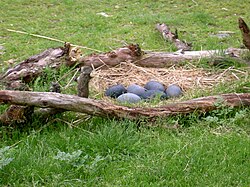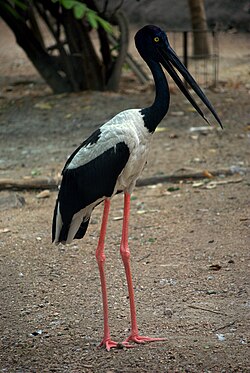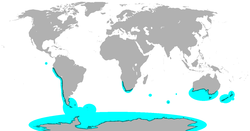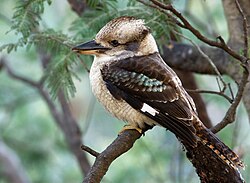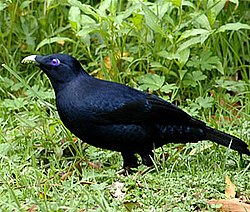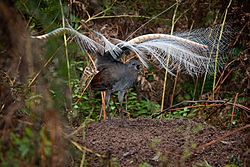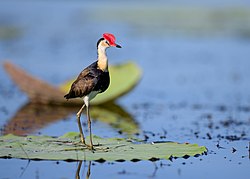AY Honors/Australian Birds/Answer Key
1.a. Which is the largest of the Australian birds?
The Emu is the second largest bird in the world by height (after the ostrich)and is widely found in Australia. The largest emus can reach up to 1.5–1.9 m (4.9–6.2 ft) in height, 1–1.3 m (3.3–4.3 ft) at the shoulder. In length measured from the bill to the tail, emus range from 139 to 164 cm (55 to 65 in), with males averaging 148.5 cm (58.5 in) and females averaging 156.8 cm (61.7 in). Emus weigh between 18 and 60 kg (40 and 132 lb), with an average of 31.5 and 36.9 kg (69 and 81 lb) in males and females, respectively. Females are usually larger than males by a small amount, and are substantially wider across the rump.
However, according to this list of the largest birds, the Southern and Northern Cassowary are both on average heavier and larger than the Emu, but not always as tall. So the answer depends on how you define "largest".
1. b. Describe its nest, including number, size and colour eggs and how incubated.
Male Emu lose their appetite and construct a rough nest in a semi-sheltered hollow on the ground from bark, grass, sticks, and leaves.[3] The nest is almost always a flat surface rather than a segment of a sphere, although in cold conditions the nest is taller, up to 7 cm tall, and more spherical to provide more insulation. When other material is lacking, it can also use spinifex grass bushes more than a metre across, despite the prickly nature. The nest can be placed in open ground or near scrubs and rocks, although thick grass is usually present if the emu takes the former option. The nests are usually placed in an area where the emu has a clear view of the surrounds and can detect predators.
The pair mates every day or two, and every second or third day the female lays one of an average of 11 (and as many as 20) very large, thick-shelled, dark-green eggs. The shell is around 1 mm thick although indigenous Australians say that northern eggs are thinner. The number of eggs varies with rainfall. The eggs are on average 134 by 89 millimetres (5.3 in × 3.5 in) and weigh between 700 and 900 grams (1.5 and 2.0 lb),[49] which is roughly equivalent to 10–12 chicken eggs in volume and weight. The egg surface is granulated and pale green. During the incubation period, the egg turns dark green, although if the egg never hatches, it will turn white from the bleaching effect of the sun.
The male Eu becomes broody after his mate starts laying, and begins to incubate the eggs before the laying period is complete. From this time on, he does not eat, drink, or defecate, and stands only to turn the eggs, which he does about 10 times a day. Sometimes he will walk away at night; he chooses such a time as most predators of emu eggs are not nocturnal. Over eight weeks of incubation, he will lose a third of his weight and will survive only on stored body-fat and on any morning dew that he can reach from the nest.
The male cassowary builds a nest on the ground; a mattress of herbaceous plant material 5 to 10 centimetres (2–4 in) thick and up to 100 centimetres (39 in) wide. This is thick enough to let moisture drain away from the eggs. The male also incubates the eggs and raises the chicks alone. A clutch of three or four eggs are laid measuring 138 by 95 millimetres (5.4 in × 3.7 in). They have a granulated surface and are initially bright pea-green in colour although they fade with age.
1. c. How fast can this bird run?
Emu can sprint at 50 km/h (31 mph). Cassowary are also fast runners, attaining speeds up to 48 km (30 mi) per hr. Both birds are flightless and run about the same maximum speed.
1. d. Which is the tallest 'flying' bird?
Sarus crane (Grus antigone) is a large non-migratory crane found in parts of the Indian Subcontinent, Southeast Asia and Australia. The tallest of the flying birds, standing at a height of up to 1.8 m (5.9 ft).
1. e. Can you name Australia's only native stork?
The Black-necked Stork is the only stork found in Australia. With black and white body plumage, glossy dark green and purple neck and massive black bill, it is easily identified from all other Australian birds. The legs are long and coral-red in colour. The female is distinguished by its yellow eyes while males have brown irises.
2. Are penguins found naturally in Australia and if so, where would you go to observe penguins?
Penguins live along the southern coast of Australia and other areas of the world (see map). Check ocean beaches.
3. a. Which bird is known as the "Laughing Jackass"?
The laughing kookaburra
3. b. To which species does it belong?
D. novaeguineae
3. c. What is unusual about the family makeup of this bird?
Most species of kookaburra tend to live in family units, with offspring helping the parents hunt and care for the next generation of offspring. Now that is unusual in any species!
4. a. Name at least 2 birds who incubate their eggs in the ground.
All flightless birds including the emu, cassowary, and penguin (and some flying birds) incubate on the grounds.
4. b. Describe how the nest is built and eggs are laid and incubated for one of these birds.
Emu and cassowary nests and eggs and described in Question 1
Penguins form monogamous pairs for a breeding season, though the rate the same pair recouples varies drastically. Most penguins lay two eggs in a clutch, although the two largest species, the emperor and the king penguins, lay only one. With the exception of the emperor penguin, where the male does it all, all penguins share the incubation duties. These incubation shifts can last days and even weeks as one member of the pair feeds at sea. If they make a nest (some just hold the eggs with their feet) they make the nest among and from rocks, generally as part of a large colony of nesting penguins.
4. c. What is the term which describes this type of bird?
Ground nesting birds often build scrape style nests.
5. a. What does the Bower Bird use his bower for and what colour is the Satin Bower Bird known to 'steal' to decorate the bower?
A bower is large structure made of grass and bright objects, used by the bower bird during courtship displays to attract a mate. They prefer blue items.
5. b. Can you name a Bower Bird which lives in your state?
Check the ranges of the various bower bird species to find one that lives in your state. If no Bower Birds live in your state (you live outside the range of the bird), consider picking an Australian state and figuring out one that lives there.
6. Where does the Lyre Bird get his name and what is special about his song?
The lyrebird's name came from an ignorant mistake, perpetrated in a famous painting. The male bird has a spectacular tail, consisting of 16 highly modified feathers (two long slender lyrates at the centre of the plume, two broader medians on the outside edges and twelve filamentaries arrayed between them).
File:Lyre bird.jpg John Gould's early 1800s painting of a superb lyrebird specimen at the British Museum This happened when a superb lyrebird specimen (which had been taken from Australia to England during the early 19th century) was prepared for display at the British Museum by a taxidermist who had never seen a live lyrebird. The taxidermist mistakenly thought that the tail would resemble a lyre, and that the tail would be held in a similar way to that of a peacock during courtship display, and so he arranged the feathers in this way. Later, John Gould (who had also never seen a live lyrebird), painted the lyrebird from the British Museum specimen.
Although very beautiful, the male lyrebird's tail is not held as in John Gould's painting. Instead, the male lyrebird's tail is fanned over the lyrebird during courtship display, with the tail completely covering his head and back—as can be seen in the image below and also the image of the 10 cent coin, where the superb lyrebird's tail (in courtship display) is portrayed accurately.
A lyrebird's song is one of the more distinctive aspects of its behavioural biology. Lyrebirds sing throughout the year, but the peak of the breeding season, from June to August, is when they sing with the most intensity. During this peak they may sing for four hours of the day, almost half the hours of daylight. The song of the superb lyrebird is a mixture of seven elements of its own song and any number of other mimicked songs and noises. The lyrebird's syrinx is the most complexly-muscled of the Passerines (songbirds), giving the lyrebird extraordinary ability, unmatched in vocal repertoire and mimicry. Lyrebirds render with great fidelity the individual songs of other birds and the chatter of flocks of birds, and also mimic other animals such as koalas and dingos. The lyrebird is capable of imitating almost any sound and they have been recorded mimicking human caused sounds such as a mill whistle to a cross-cut saw, chainsaws, car engines and car alarms, fire alarms, rifle-shots, camera shutters, dogs barking, crying babies, music, and even the human voice. However, while the mimicry of human noises is widely reported, the extent to which it happens is exaggerated and the phenomenon is quite unusual.
The superb lyrebird's mimicked calls are learned from the local environment, including from other superb lyrebirds. An instructive example of this is the population of superb lyrebirds in Tasmania, which have retained the calls of species not native to Tasmania in their repertoire, but have also added some local Tasmanian endemic bird noises. It takes young birds about a year to perfect their mimicked repertoire. The female lyrebirds of both species are also mimics, and will sing on occasion but the females do so with less skill than the males. A recording of a superb lyrebird mimicking sounds of an electronic shooting game, workmen and chainsaws was added to the National Film and Sound Archive's Sounds of Australia registry in 2013.
One researcher, Sydney Curtis, has recorded flute-like lyrebird calls in the vicinity of the New England National Park. Similarly, in 1969, a park ranger, Neville Fenton, recorded a lyrebird song which resembled flute sounds in the New England National Park. After much detective work by Fenton, it was discovered that in the 1930s, a flute player living on a farm adjoining the park used to play tunes near his pet lyrebird. The lyrebird adopted the tunes into his repertoire, and retained them after release into the park. Neville Fenton forwarded a tape of his recording to Norman Robinson. Because a lyrebird is able to carry two tunes at the same time, Robinson filtered out one of the tunes and put it on the phonograph for the purposes of analysis. The song represents a modified version of two popular tunes in the 1930s: "The Keel Row" and "Mosquito's Dance". Musicologist David Rothenberg has endorsed this information.
7. a. Which is Australia's largest bird of prey and what is its wingspan? Can you name another bird with the same wingspan?
Wedge-tailed Eagles use the updrafts of thermals or hillslopes to rise effortlessly rarely needing to flap their huge wings. They soar very high in great circles. Wingspan typically is between 182 and 232 cm (6 ft 0 in and 7 ft 7 in) with the verified record being 284 cm (9 ft 4 in). This is similar to the bald eagle.
7. b. What is different about the vision of birds of prey compared to other birds?
The Wedge-tailed Eagle have sophisticated binocular vision which enables them to accurately assess distances and pinpoint their prey. Their eyes also are equipped with bony rings which can squeeze and elongate the eyeball. This has the same effect as a telephoto lens on a camera. It enlarges the image seen by the bird. This is very unusual.
7. c. What is the fastest bird of prey? At what speed is it known to fly (dive)?
According to this list, the fastest bird of prey is the Peregrine Falcon with a maxium dive speed of 389 km/h or 242 mph! Now that is fast!
7. d. Name another bird, which is not a bird of prey, known for its fast flying.
The Grey-headed albatross is a very fast sea bird found in the Southern Ocean.
8. Which swan is native (not introduced) to Australia?
9. Where do the following birds get their name:
a. The Wattle bird?
b. The Catbird?
c. The Butcher bird?
d. The Whip bird?
10. The Greater Frigate Bird (male) has a throat pouch. What colour is it what is it used for?
11. Which bird is known as a "Christbird" and why?
The Jacana is known for walking on water (lilypads and other vegetation actually).
12. Name the birds used in Australian emblems.
| Area | Coat of Arms Birds | Official Bird |
|---|---|---|
| National | Emu support, with Piping Shrike and Black Swan on shield | Emu |
| New South Wales | No birds | Kookaburra |
| Victoria | No birds | Helmeted Honeyeater |
| Queensland | Brolga | Brolga |
| Western Australia | Black Swan | Black Swan |
| Tasmania | none | none |
| Australia Capital Territory | Australian black swan, representing Aborigines, and European white mute swan, representing white settlers. | Gang-gang Cockatoo |
| Northern Territory | Wedge-tailed Eagle | Wedge-tailed Eagle |
13. Which bird is famous for its dances?
14. Besides sitting on their eggs or building a mound, there is one other method by which birds incubate their eggs. What is this method called and name one bird which uses this method.
15. How is the cormorant able to dive for food?
16. Australia has a wide variety of native finches. Name 5 including at least one from your state. Describe your favourite and describe where you would go to look for it.
References
https://en.wikipedia.org/wiki/Sarus_crane https://en.wikipedia.org/wiki/Black-necked_stork http://www.birdsinbackyards.net/species/Ephippiorhynchus-asiaticus http://www.alicespringsdesertpark.com.au/kids/nature/birds/eagle.shtml https://en.wikipedia.org/wiki/Lyrebird
